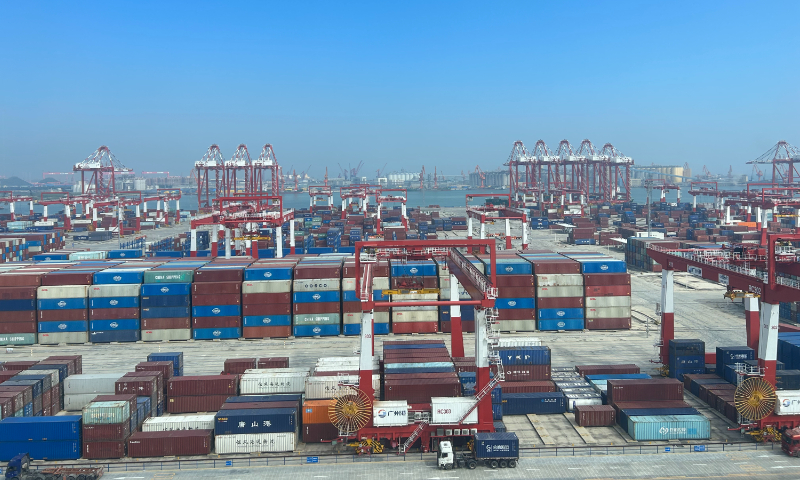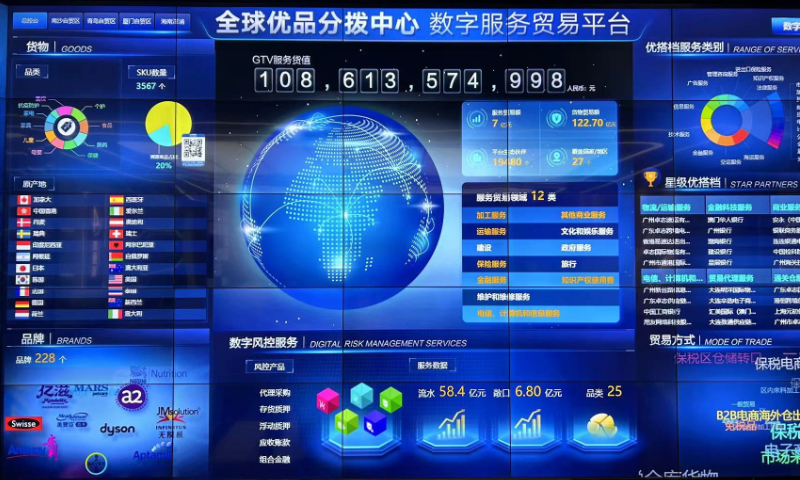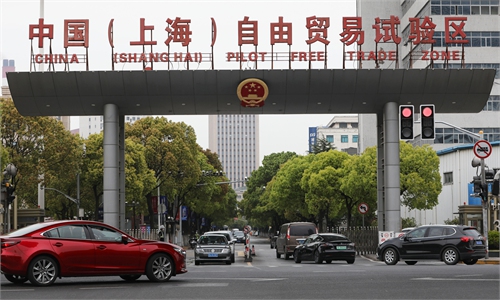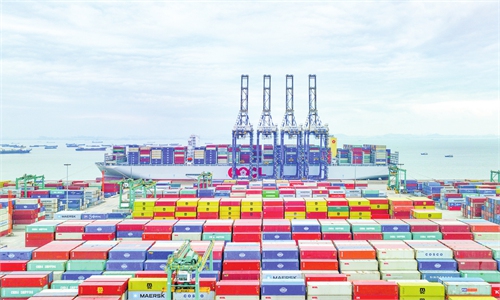Guangzhou's Nansha leads in smart port development, digitalized trade
China's FTZs lead in managerial innovation as the country opens wider

A view of Nansha Port Phase IV Project in Guangzhou, South China's Guangdong Province photo: Qi Xijia/ GT
At a container terminal south of Guangzhou, Guangdong Province, there is a surprising sight: a vast area spanning over 2,400 meters in length and 650 meters in width, with hardly any human presence. Instead, an automated rail mounted gantry (RMG) crane skillfully handles the containers, placing them onto self-driving port trucks. The trucks then transport the containers to the automated ship-to-shore cranes for loading onto ships.
The smart port, known as the Nansha Port Phase-IV Project, is a remarkable undertaking within the China (Guangdong) Pilot Free Trade Zone (FTZ) Nansha Area of Guangzhou, South China's Guangdong Province.
As the nation's first digital service trade aggregation platform, the Nansha FTZ is leading the way in bolstering foreign trade with innovation. It also provides a clear example of how China's free trade zones serve as pioneers for trade facilitation and opening-up.
Since its inauguration in 2015, the policies and incentives offered by the free trade zone had transformed Nansha into an advanced gateway for international trade. Its strategic location, excellent port facilities, and international trade routes made it an ideal hub for the circulation of goods.
Intelligent management
The Phase-IV project officially commenced operations in July 2022. It is designed to have annual throughput capacity of 4.9 million TEUs (twenty-foot equivalent units) and integrates technologies such as BeiDou navigation, 5G communication, artificial intelligence, and unmanned driving, creating more than 60 patents, including 31 invention patents, according to Xinhua News Agency.
The chief engineer of the Nansha Port Phase-IV Project, Huang Binglin, told the Global Times that that due to the automation design only around four to five workers are needed for the yard.
"The workers responsible for operating the cantilever RMG had transitioned from a traditional setup of four workers per crane to a single worker managing 10 cranes. They are needed mainly to handle unexpected situations, as the operation is fully automated," Huang said.
Self-driving trucks can work continuously for 24 hours, powered by lithium batteries with zero emissions, and could even recharge themselves.
Thanks to these automated designs, the workforce had been reduced by 70 percent compared with traditional port, yet the efficiency of loading and unloading had increased. The smart port could now handle 30 containers per hour, compared to the previous 26 containers for the traditional port, Huang said.
Furthermore, the Nansha Port had made significant progress in cold chain logistics, which was closely linked to the development of the Nansha's cold chain industry, Chen Wei, a logistic center director with Guangzhou Port Group, told the Global Times.
In 2022, the Nansha Port Area imported cold chain goods worth 22.74 billion yuan ($3.10 billion), with a year-on-year growth of 81.9 percent. In 2023, Nansha Port became the largest import port for cherries and durians in Chinese mainland.
Thanks to the continuous optimization of port infrastructure, logistics support services, and smart customs clearance, the overall customs clearance efficiency of imported fruits has increased by more than 25 percent.
Imported cold chain goods that have been cleared through customs can be delivered to major cities in the Guangdong-Hong Kong-Macao Greater Bay Area within one hour through "shipside direct pick-up," and can reach all parts of the country within 24 hours.
By 2022, the Nansha Port's container throughput had reached 18.39 million TEUs. In the same year, the total import and export volume of the Nansha FTZ reached 210.9 billion yuan, a year-on-year increase of 42.6 percent.
Digital Integration
Additionally, the Nansha FTZ is stepping up the building of digital trade eco-system to further facilitate trade activities with the launch of the country's first digital service trade aggregation platform, the Global Quality Distribution Center Digital Service Trade Platform (referred to as DSTP).
Yu Chonggang, President of DSTP told the Global Times that the goal of the platform is to help enterprises with global trade demands integrate the core elements of trade using digital technology.
"Since the platform's launch in 2020, over 1,000 enterprises, including banks, logistics companies, brokers, and distribution channels, had joined the platform," Yu said, "the enterprises could find all the necessary service providers on the platform, connecting to the global market."

A display board at Global Quality Distribution Center Digital Service Trade Platform (DSTP) in Guangzhou, South China's Guangdong Province photo: Qi Xijia/GT
Nansha is home to numerous outstanding service providers, including foreign trade service platforms, logistics integration platforms, and digital supply chains. By aggregating these resources, it was easy to form comprehensive solutions that could help both domestic and foreign brands establish themselves in Nansha and conduct global business, Yu said.
"With Nansha a starting point, we plan to promote the mode of digital service trade platform to other parts of the country," Yu said.
Since the establishment of the first pilot FTZ in Shanghai in 2013, China has so far established 21 FTZs in addition to the Hainan Free Trade Port, according to Xinhua News Agency.
As China aims to further open up its economy and facilitate global trade, the establishment of FTZs, including Nansha, serve as experimental zones for testing new reforms before implementing them nationwide. They also function as a pilot area for trade facilitation, investment liberalization, and financial innovation, providing valuable insights for China's overall economic development, experts said.
To date the Nansha FTZ has accumulated 913 innovational achievements which are then promoted nationwide.
Additionally, over the past decade, 278 forms of institutional innovations have been formulated in FTZs around the countries and then replicated nationwide, covering investment facilitation, trade liberalization, financial opening-up, among other fields, Xinhua reported.
Over the past decade, China's FTZs have played a crucial role in stabilizing foreign trade. In 2022, the 21 FTZs saw exports and imports rise 14.5 percent year-on-year to 7.5 trillion yuan, accounting for 17.8 percent of the country's total.



